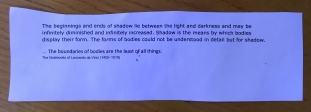In relation to the Outside/Inside project I have began to look at sources other than artwork. After thinking about dreams the movie ‘Inception’ came to mind so I decided to re-watch the film and pick out parts which I found informative towards the idea of studying dreams.
This film uses clever cinematography and narrative to give a good representation of dreams. The main character ‘Cobb’ has an ability to enter peoples dreams and steal their secrets from their subconscious. In a scene from the film is talks about how worlds are created in dreams, ‘Cobb’ explains how “our mind creates and perceives our worlds simultaneously”. This scene also talks about how the human mind creates worlds and situations so good that we don’t know it. This is how dreams feel realistic until we wake up and realise something was strange.
This film also plays on the theme of dreams vs reality. ‘Cobb’ uses a totem which is an object to test whether he is in a dream or reality. The object is a spinning top that stops spinning if he is in reality.
(Inception 2010)













